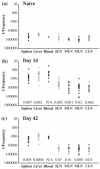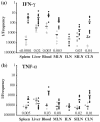In vivo compartmentalization of functionally distinct, rapidly responsive antigen-specific T-cell populations in DNA-immunized or Salmonella enterica serovar Typhimurium-infected mice
- PMID: 15501769
- PMCID: PMC523063
- DOI: 10.1128/IAI.72.11.6390-6400.2004
In vivo compartmentalization of functionally distinct, rapidly responsive antigen-specific T-cell populations in DNA-immunized or Salmonella enterica serovar Typhimurium-infected mice
Abstract
The location and functional properties of antigen-specific memory T-cell populations in lymphoid and nonlymphoid compartments following DNA immunization or infection with Salmonella were investigated. Epitope-specific CD8+ -T-cell expansion and retention during the memory phase were analyzed for DNA-immunized mice by use of a 5-h peptide restimulation assay. These data revealed that epitope-specific gamma interferon (IFN-gamma)-positive CD8+ T cells occur at higher frequencies in the spleen, liver, and blood than in draining or peripheral lymph nodes during the expansion phase. Moreover, this distribution is maintained into long-term memory. The location and function of both CD4+ and CD8+ Salmonella-specific memory T cells in mice who were given a single dose of Salmonella enterica serovar Typhimurium was also quantitated by an ex vivo restimulation with bacterial lysate to detect the total Salmonella-specific memory pool. Mice immunized up to 6 months previously with S. enterica serovar Typhimurium had bacterium-specific CD4+ T cells that were capable of producing IFN-gamma or tumor necrosis factor alpha (TNF-alpha) at each site analyzed. Similar findings were observed for CD8+ T cells that were capable of producing IFN-gamma, while a much lower frequency and more restricted distribution were associated with TNF-alpha-producing CD8+ T cells. This study is the first to assess the frequencies, locations, and functions of both CD4+ and CD8+ memory T-cell populations in the same Salmonella-infected individuals and demonstrates the organ-specific functional compartmentalization of memory T cells after Salmonella infection.
Figures








Similar articles
-
Role for inducible costimulator in control of Salmonella enterica serovar Typhimurium infection in mice.Infect Immun. 2006 Feb;74(2):1050-61. doi: 10.1128/IAI.74.2.1050-1061.2006. Infect Immun. 2006. PMID: 16428752 Free PMC article.
-
The cytokine balance in the maintenance of a persistent infection with Salmonella enterica serovar Typhimurium in mice.Cytokine. 2006 Feb 21;33(4):212-8. doi: 10.1016/j.cyto.2006.02.002. Epub 2006 Mar 31. Cytokine. 2006. PMID: 16580226
-
Processing of viable Salmonella typhimurium for presentation of a CD4 T cell epitope from the Salmonella invasion protein C (SipC).Eur J Immunol. 2002 Sep;32(9):2664-71. doi: 10.1002/1521-4141(200209)32:9<2664::AID-IMMU2664>3.0.CO;2-N. Eur J Immunol. 2002. PMID: 12207351
-
DNA vaccination: the answer to stable, protective T-cell memory?Curr Opin Immunol. 2003 Aug;15(4):471-6. doi: 10.1016/s0952-7915(03)00068-2. Curr Opin Immunol. 2003. PMID: 12900281 Review.
-
Immune response to infection with Salmonella typhimurium in mice.J Leukoc Biol. 2000 Apr;67(4):457-63. doi: 10.1002/jlb.67.4.457. J Leukoc Biol. 2000. PMID: 10770276 Review.
Cited by
-
Pre-existing immunity against vaccine vectors--friend or foe?Microbiology (Reading). 2013 Jan;159(Pt 1):1-11. doi: 10.1099/mic.0.049601-0. Epub 2012 Nov 22. Microbiology (Reading). 2013. PMID: 23175507 Free PMC article. Review.
-
Innate Activation of IFN-γ-iNOS Axis During Infection With Salmonella Represses the Ability of T Cells to Produce IL-2.Front Immunol. 2020 Mar 25;11:514. doi: 10.3389/fimmu.2020.00514. eCollection 2020. Front Immunol. 2020. PMID: 32269573 Free PMC article.
-
Protective host immune responses to Salmonella infection.Future Microbiol. 2015;10(1):101-10. doi: 10.2217/fmb.14.98. Future Microbiol. 2015. PMID: 25598340 Free PMC article. Review.
-
Interferon-γ production by neutrophils during bacterial pneumonia in mice.Am J Respir Crit Care Med. 2011 May 15;183(10):1391-401. doi: 10.1164/rccm.201004-0592OC. Epub 2010 Dec 17. Am J Respir Crit Care Med. 2011. PMID: 21169470 Free PMC article.
-
Homologous prime-boost immunization with live attenuated Salmonella enterica serovar Senftenberg and its preventive efficacy against experimental challenge with various strains of S. Senftenberg.BMC Vet Res. 2017 Jan 31;13(1):39. doi: 10.1186/s12917-017-0960-4. BMC Vet Res. 2017. PMID: 28143524 Free PMC article. Clinical Trial.
References
-
- Andersson, Å., W. J. Dai, J. P. Di Santo, and F. Brombacher. 1998. Early IFN-γ production and innate immunity during Listeria monocytogenes infection in the absence of NK cells. J. Immunol. 161:5600-5606. - PubMed
-
- Badovinac, V. P., G. A. Corbin, and J. T. Harty. 2000. Cutting edge: OFF cycling of TNF production by antigen-specific CD8+ T cells is antigen independent. J. Immunol. 165:5387-5391. - PubMed
-
- Badovinac, V. P., and J. T. Harty. 2000. Adaptive immunity and enhanced CD8+ T cell response to Listeria monocytogenes in the absence of perforin and IFN-γ. J. Immunol. 164:6444-6452. - PubMed
-
- Badovinac, V. P., and J. T. Harty. 2000. Intracellular staining for TNF and IFN-gamma detects different frequencies of antigen-specific CD8(+) T cells. J. Immunol. Methods 238:107-117. - PubMed
-
- Badovinac, V. P., B. B. Porter, and J. T. Harty. 2002. Programmed contraction of CD8 T cells after infection. Nat. Immunol. 3:619-626. - PubMed
Publication types
MeSH terms
Substances
LinkOut - more resources
Full Text Sources
Research Materials
Miscellaneous

